(Re)Discovering Charles Dekeukeleire
Kristin Thompson
June 2009
[Introduction note: I have not attempted to update this
article, which was originally published in Millennium Film Journal Nos.
7/8/9 (Fall-Winter, 1980-81). With the recent release of three of the four films
I discuss in the article on a DVD set, “Avant-Garde
1927–1937,” by
the Belgian film archive, Dekeukeleire’s work is not quite as neglected
as it was at that time. (See my comments on the DVDs on the
blog.)
The Belgian cinema has gained a slightly higher profile on world cinema markets,
most notably with the work of the Dardennes brothers.]
I. Introduction
The parentheses in my title arise from the fact that Charles Dekeukeleire,
a largely forgotten Belgian experiment filmmaker of the late 1920s, had only
small recognition in his own day. Hans Scheugl and Ernst Schmidt, Jr., in their
admirable reference book, Eine Subgeschichte des Films: Lexicon des Avantgarde-,
Experimental-, und Undergroundfilms, say of his films: “They were
so advanced in their formal means, so far ahead of their time, that they left
behind the puzzled contemporary critics.” 1 There
were in fact a few contemporary Belgian writers who discussed Dekeukeleire’s
films with insight, but certainly this minority response was not enough to insure
his work a place in cinema history after he turned to documentary filmmaking
in the 1930s. 1 There
were in fact a few contemporary Belgian writers who discussed Dekeukeleire’s
films with insight, but certainly this minority response was not enough to insure
his work a place in cinema history after he turned to documentary filmmaking
in the 1930s.
I first encountered Dekeukeleire’s name in researching a study of European
avant-garde styles of the 1920s. The journal Close-up refers several
times to his films, Witte Vlam and Histoire de détective,
so I put them on my list of films to see. Several archives I visited had no prints,
but the Royal Film Archive of Belgium had not only these two, but also two earlier
films called Combat de boxe and Impatience—these four
constituting Dekeukeleire’s entire silent experimental output. After watching
the four, I found myself in a situation that comes but rarely to researchers.
Having included Dekeukeleire’s films only through a desire for completeness
and knowing virtually nothing about them, I had the pleasure of seeing two good
films and two masterpieces. I write about them here not with the desire to tantalize
readers with unseeable films, but in the hope of generating interest which might
lead to a wider availability of Dekeukeleire’s work.
II. Dekeukeleire and His Situation
Belgium in the 1920s occupied much the same minor position in the world film
market as it does currently. The main difference seems to be that, while today
there is very little commercial filmmaking in that country, in the silent period
there was none at all. Belgium was supplied with films primarily by the United
States (which had dominated the world market since World War I) and France.
As in most of the non-film-producing countries of Europe, there grew up in
Belgium during the twenties a ciné-club movement that fostered amateur
production. The first club formed, the Ciné-Club de Belgique, was modeled
on the initial French ciné-club started by Louis Delluc. The Ciné-Club
de Belgique began in June of 1921 and went on sporadically for several years,
meeting whenever a theatre in Brussels was available. It also published the Revue
Belge du Cinéma in 1921. Various other groups attempted weekly screenings,
but finally in 1927 the movement gained some real strength. Several enthusiasts
founded the Club du cinema, housed in the Palais des Beaux-Arts. It’s “Studio” theatre
copied the Ursulines and Vieux-Colomier in Paris by selling tickets to the public—thus
becoming Belgium’s first “art-house” cinema. Several other
towns had ciné-clubs by the end of the decade, including one in Ostend. 2 2
Heading the latter was a young man, Henri Storck, who began making films in
the late 1920s. His short documentary, Images d’Ostende, is an
impressive study of the harbor town and bears some resemblance to Joris Ivens’ early
work. Storck was to become a major documentarist, one of the two key Belgian
filmmakers to emerge from the twenties. The other was Dekeukeleire.
Dekeukeleire was born in 1905. He received a classical education, studying
Greek and Latin in college and graduating in 1922 or 1923, at the age of 18.
At this point his saw Delluc’s Fievre and Abel Gance’s La
roue and became interested in the cinema. 3 He
worked as a film critic, publishing his first piece, a review of Jean Epstein’s La
Belle Nivernaise, in the French journal Cinéa, in 1924.
In Belgium, he wrote for various art journals. He began making films himself
in 1927, the same year as the flowering of the Belgian ciné-club movement,
upon which he depended to a considerable extent for support. His silent experimental
films were: Combat de boxe (1927), Impatience (1929), Histoire
de détective (1930), and Witte Vlam (also called Flamme
blanche, 1930). There after he had a long career as a relatively prominent
documentarist. 3 He
worked as a film critic, publishing his first piece, a review of Jean Epstein’s La
Belle Nivernaise, in the French journal Cinéa, in 1924.
In Belgium, he wrote for various art journals. He began making films himself
in 1927, the same year as the flowering of the Belgian ciné-club movement,
upon which he depended to a considerable extent for support. His silent experimental
films were: Combat de boxe (1927), Impatience (1929), Histoire
de détective (1930), and Witte Vlam (also called Flamme
blanche, 1930). There after he had a long career as a relatively prominent
documentarist.
During this brief period as an experimentalist, Dekeukeleire set himself up
in as independent a set of production circumstances as he could manage. He owned
his own 35mm camera and lighting equipment, and he used bedrooms and sheds as
studios. His friends scripted and acted in his films, and he served in all other
production roles: “I do everything myself: I buy the raw stock and
when it leaves me, it is a film. I direct, I operate and I develop myself.” 4 He
prided himself on his anti-establishment situation and his refusal to compromise.
His career during the late twenties recalls that of Carl Dreyer, whose uncompromising
attitude limited his ability to work. In fact, Dekeukeleire admired Dreyer greatly.
Real film artists, Dekeukeleire considered, could not work in commercial studio
conditions: “That is the case with Dreyer, it is true, the most independent
of all, who has not produced more than two films in five years.” 4 He
prided himself on his anti-establishment situation and his refusal to compromise.
His career during the late twenties recalls that of Carl Dreyer, whose uncompromising
attitude limited his ability to work. In fact, Dekeukeleire admired Dreyer greatly.
Real film artists, Dekeukeleire considered, could not work in commercial studio
conditions: “That is the case with Dreyer, it is true, the most independent
of all, who has not produced more than two films in five years.” 5 Dekeukeleire
delighted in describing to interviewers his primitive, improvised production
situations, and especially how little his films cost to produce. Few directors
in that period before government and foundation grants could so well have fit
the label “independent filmmaker.” 5 Dekeukeleire
delighted in describing to interviewers his primitive, improvised production
situations, and especially how little his films cost to produce. Few directors
in that period before government and foundation grants could so well have fit
the label “independent filmmaker.”
Indeed, Dekeukeleire’s career seems to define the outer limits to which
a filmmaker could go in the silent period with virtually no support. After four
experimental films, it proved impossible for him to continue filmmaking in the
same isolated way. To a certain extent we can say that Dekeukeleire was born
before his time—not in the usual sense that audiences were not yet prepared
to understand his films (although this is true—I think audiences accustomed
to Snow, Conrad, and structural filmmaking probably have a better preparation
for Dekeukeleire’s work than his contemporaries did). Rather, the filmmaking
establishment was not set up in ways which could accommodate people like him.
He could not accept the compromise of working within commercial feature filmmaking
on a commission basis, as some of the Germans did. Filmmakers like Richter and
Fischinger could do shorts or special sequences for the big German concerns while
continuing their own work on the side. But Belgium had no commercial industry,
and Dekeukeleire’s experience in dealing directly with the large exhibitors
on Combat de boxe closed that route for him, as we shall see. In France, the
experimentalists worked within the mainstream film industry to a considerable
extent, alternating popularly oriented films with their more avant-garde work,
or depending on the well-developed French ciné-club system for commissions.
Dekeukeleire followed this latter tack, but his films failed to break past Belgium
and France into the broader experimental market (such as the London Film Society)
to any extent. A screening of Impatience at the 1929 Film und Foto exhibition
in Stuttgart seems to have met with an indifferent reception.
From 1932 to 1934, Dekeukeleire served as the Belgian correspondent for a
French newsreel produced by Germaine Dulac. Then he set out for the Belgian Congo
to do a documentary. His stay in Africa seems to have been a turning point for
Dekeukeleire. A generous interpretation would state that he changed into a liberal
humanist director of documentaries, a path he pursued until his death in 1971.
But to an admirer of his silent experimental works, the change is a depressing
one. I have sampled a few of his documentaries, and they have none of the fascination
imparted by a Resnais or a Marker. Rather, they are exactly the kind of films
a business firm, a national tourist board, or a charity hopes for when giving
out a commission: well-made, reasonably interesting, unexceptional in both sense
of that word. He remained somewhat leftist, favoring subjects that allowed him
to show the dignity and beauty of human labor (as the 1938 title Chanson
de toile suggests). He also refused to cooperate with the occupation forces
during World War II. His entire output from the war years was a few short films,
done for Belgian charities. In all, he made eighty-three films, in addition to
newsreel and television work, according to his own statement, 6 gaining
himself an honored but minor status in documentary film circles. He died in 1971. 6 gaining
himself an honored but minor status in documentary film circles. He died in 1971.
III. The Films
Combat de boxe and Witte Vlam, although both interesting
and well-made works, are less original and startling than the two works that
came between them. I shall discuss these briefly, then spend the remainder of
this essay on Dekeukeleire’s two masterpieces, Impatience and Histoire
de détective.
Combat de boxe resembles French traditions of experimental filmmaking
in the 1920s. Taking a simple event, a brief bout between two boxers, Dekeukeleire
abstracts it through the use of numerous filmic tricks—negative footage,
superimpositions, jump cuts, and extremely rapid rhythmic cutting. He shot the
film in his own bedroom, using a sheet stretched on the floor as the canvas of
the ring, surrounded by ropes. Two actual boxers took part. Using Kuleshov-effect
editing, Dekeukeleire inserts long shots of the crowd apparently looking on.
Through most of the film, the crowd shots appear in negative, while the boxers
are on positive stock. At times, the filmmaker superimposes the boxers’ faces
in positive over the negative crowd images. Several stretches of the film are
rhythmic series of quick shots with sections of black leader, ranging from eight
frames down to an occasional single-frame shot. By alternating a close-up and
a medium close-up of a clenched fist, Dekeukeleire achives a pulsing effect,
as if the hand were striking toward the audience. This literalist approach to
aggression against the spectator would become less overt in his later films,
where the films of the films themselves take the aggressive part. In general, Combat
de boxe is Dekeukeleire’s least distinctive experimental film.
Dekeukeleire atttempted to get Combat de boxe into commercial distribution
in Belgium. Paramount’s theatre in Brussels, the Coliseum, contracted to
use it as a short before the feature presentation, Chang. The exhibitor
was to pay Dekeukeleire 750F; apparently the filmmaker was naive enough to agree
to this by verbal contract only. After several days of screenings, the exhibitor
cut portions of the print, and Dekeukeleire sued to have the showings stopped
and to get his 750F plus 10,000F in damages. The case dragged on for some time
and was decided against Dekeukeleire in August 1928. He appealed and lost again
in 1931. 7 7
He met with better luck outside commercial distribution, in the ciné-club
circles. In early 1928, the Théâtre des Ursulines in Paris was showing
Germaine Dulac’s La Coquille et le clergyman. Due to hostile demonstrations
by scenarist Antonin Artaud’s friends, the theatre was forced to take the
film off the program; Combat de boxe replaced it. 8 Dekeukeleire’s
film received favorable reviews and ran for three months. From that point on,
he worked entirely within the ciné-club circuit for exhibiting his experimental
films, but even this did not guarantee his subsequent work particularly sympathetic
responses. 8 Dekeukeleire’s
film received favorable reviews and ran for three months. From that point on,
he worked entirely within the ciné-club circuit for exhibiting his experimental
films, but even this did not guarantee his subsequent work particularly sympathetic
responses.
Although Dekeukeleire’s fourth film is often called Flamme blanche,
its actual title is in Flemish, Witte Vlam. (Dekeukeleire was of Flemish
ancestry, but this is the only “Flemish” film of the four experimentals.)
The filmmaker called this work “a look backward,” 9 since
it lacks the radical experimentation of Impatience and Histoire
de détective. Here instead a considerable influence from Vertov and
Eisenstein is apparent, with “Russian” framings and cutting dominating
the non-documentary portions. 9 since
it lacks the radical experimentation of Impatience and Histoire
de détective. Here instead a considerable influence from Vertov and
Eisenstein is apparent, with “Russian” framings and cutting dominating
the non-documentary portions.
The narrative concerns a peaceful demonstration by the Flemish People’s
Party at Dixmude, an actual event which Dekeukeleire filmed. To this he adds
a specific story line about one of the demonstrators, a butcher who is injured
when police ride through the crowd. He flees to his home and is subsequently
arrested while hiding in the barn. The “white flame” of the title
refers figuratively to the immense white banner which moves in the wind in the
demonstration scene and final shot. Dekeukeleire described the title as the “poetic
equivalent of pure revolt.” 10 10
In the opening scenes of the crowds in Dixmude, Kekeukeleire inserts several
close-ups of workers’ faces, shot against the sky in Soviet fashion When
the police arrive, he suggests the action mainly through a series of static close
shots and quick cutting. After an extreme long shot of the crowd from high above,
there follows a close-up of the protagonist’s face against white, then
a close-up of gloved hands holding a horse’s reins. After a brief repetition
of each of these framings, Dekeukeleire introduces a low angle close-up of a
gendarme’s face against white. Then, through a series of thirty-six rapid
shots of sword blades, riding crops, and the butcher’s apprehensive face,
the scene builds up to the single medium close-up sot in which he is beaten.
The overall effect has little of the epic qualities of the Soviet films with
their large riot and demonstration scenes. But Dekeukeleire, with his more limited
means, uses similar montage principles to build up the effect of the conflict,
without ever trying to make the close shots appear as realistic segments of the
space shown in the documentary long shots. The film is one of the closest imitations
of Soviet montage style done n Europe during the silent period.
Witte Vlam seems to have had limited circulation. It was on the program
of the Congrès du cinéma indépendent, held at Brussels from
November 28 to December 1, 1930. (This was the second such congress, the first
having been the La Sarraz meeting of 1929, made famous in part by Eisenstein’s
participation.) There may have been other showings, but the film attracted relatively
little attention.
Dekeukeleire’s second work, Impatience, seems to me a remarkable
work, largely inexplicable through its historical context. Certainly Dekeukeleire
was familiar with the major avant-gardists of his day. In a 1933 article he said, “The
most important films of this first period will be those of Eggeling, Richter,
Ruttmann, and Fernand Léger’s Ballet mécanique which
is perhaps the masterpiece.” 11 Impatience’s
closest antecedent may indeed by Ballet mécanique, the only 1920s
film it calls to mind, but even there the resemblance is minimal. Ballet
mécanique is an ingratiating work, while Impatience seems
calculated to alienate its spectator. It is about three times as long as the
Léger-Murphy film, uses only a few objects, and has little or no humor.
Dekeukeleire structures it around rhythmic editing and relentless repetition
of this small number of elements, with limited variations. The film credits introduce “Four
characters”: 11 Impatience’s
closest antecedent may indeed by Ballet mécanique, the only 1920s
film it calls to mind, but even there the resemblance is minimal. Ballet
mécanique is an ingratiating work, while Impatience seems
calculated to alienate its spectator. It is about three times as long as the
Léger-Murphy film, uses only a few objects, and has little or no humor.
Dekeukeleire structures it around rhythmic editing and relentless repetition
of this small number of elements, with limited variations. The film credits introduce “Four
characters”:
The Mountain
The Motorcycle
The Woman
Abstract Blocks
and adds, “The human character is played by Yonnie Selma.” This
suggests that the three non-human elements will be somehow anthropomorphized,
but in the actual event, the woman becomes more of a visual object.
The film, which runs about thirty-six minutes, consists of repetitions of
these four elements. Although the suggestion is strong that the woman is riding
the motorcycle, the four elements always appear in separate shots. Dekeukeleire
films parts of the motorcycle, parts of the woman’s body, and the abstract
blocks in a studio against a white background. The woman and machine vibrate
as if jarred by the motor and road bumps, but the overall effect never simulates
real driving. The mountain appears in violently moving handheld camera shots,
vaguely suggestive of some of the quicker movement in La Region centrale.
Impatience opens with a frontal close-up of the woman in cycling
gear (Fig. 1). Her head vibrates as if she were on a cycle. Following this comes
the most extreme and mechanically rhythmic set of repetitions in the entire film:
two medium close-ups of portions of the machine also vibrating (Figs. 2 and 3).
These appear in alternation—five of each. Each shot is 53 frames (at silent
speed, about three and a third seconds each). Thirty-three frames of white leader
seem to mark an end to this segment, yet the same two shots reappear, alternating
again with ten of each shot. This time each shot is 26 frames long, about half
the previous length. After these, the first rolling handheld mountain shot occurs.
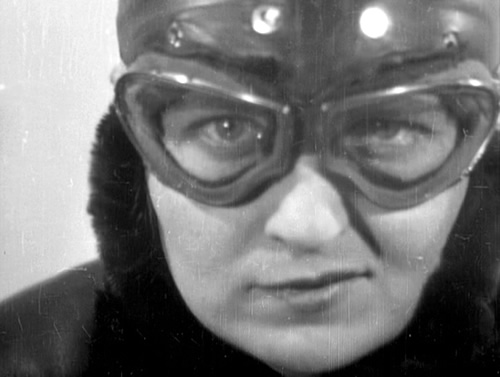
Fig. 1
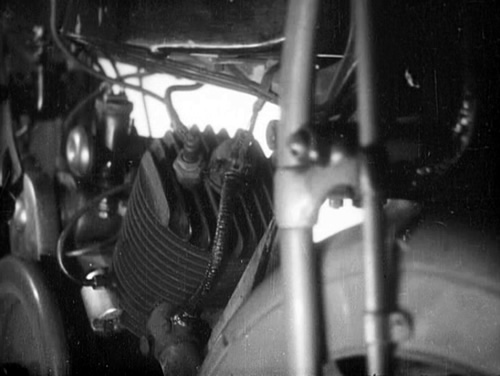
Fig. 2
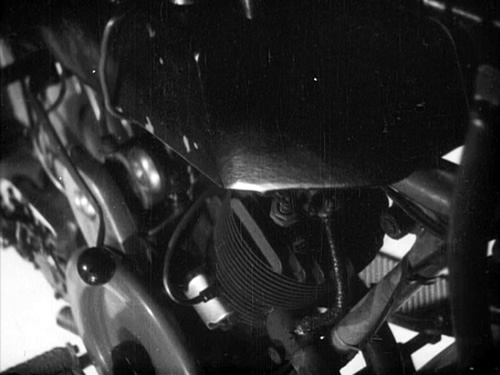
Fig. 3
So far, in spite of the lack of establishing shots, the film seems to hint
at a potential narrative situation—a woman going through the mountains
by motorcycle. Yet Dekeukeleire simply goes on with various framings of parts
of the machine and the woman’s face and body. At her second appearance,
the woman does not wear the cycling clothes. For the rest of the film, she appears
sometimes clothed, sometimes nude; in the nude shots, her body sometimes vibrates,
but not always. Dekeukeleire thus breaks down the initial hint of a narrative
situation by repeating elements with no development outside of a graphic and
rhythmic play. The woman seems to react: her face registers fear, desire, happiness,
and other emotions at various times, yet these expressions are stripped of their
status as responses by the fact that we never see a cause for them. (Again, Ballet
mécanique comes to mind, with its close-up of a woman’s face,
which changes expressions as she passes a card in front of it.) Similarly her
clothed or nude state seems only to follow graphic patterns; it makes no narrative
sense. Contemporary reviewers seemed determined to recuperate the film as a narrative,
however tenuous. Several describe the film as a woman impatiently traveling to
meet her lover—a suggestion which has no basis in the film itself. (This
interpretation depends largely on the title. When the film appeared at Stuttgart,
it went under the title Variationen der Ungeduld [Variations on
Impatience], perhaps to orient the viewers toward the film’s abstract
qualities.)
Yet there is no doubt that the film is bound up with eroticism. To a certain
extent the nudity, mild and “aesthetic” though it is, will inevitably
suggest the erotic, as do some of the woman’s facial expressions. Beyond
this, however, the film’s style and form embody this quality. Ravel’s Bolero,
in spite of its lack of subject matter, is an erotic work in this same sense.
(Indeed, imagine Bolero done in twelve-tone, twice as long, and with
no build in volume, and you have some sense of the maddening fascination of Impatience.)
After a lengthy segment which uses only the cycle, mountain, and woman, Dekeukeleire
brings in the “abstract blocks.” These are three thin, rectangular
objects, fastened parallel to each other, which swing slowly or quickly at various
points. Impatience inserts shots of these blocks at intervals among the repetitions
of the three other “characters.” At one point, a shot of the blocks
swinging in a slow arc (Fig. 4) is followed by a medium close-up of the woman,
her neck rigid, swinging her head and shoulders in a similar arc (Fig. 5). This
is perhaps the most explicit equation the film makes of the human figure to an
abstract object, but clearly such an abstraction governs the graphic patterns
of the whole film.
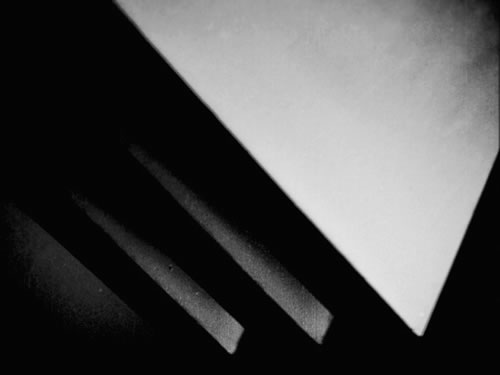
Fig. 4
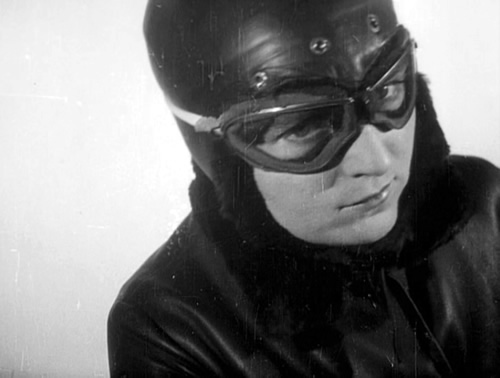
Fig. 5
By this point in his career Dekeukeleire had seen the Soviet films which were
beginning to pour into Europe in the late twenties. While Combat de boxe remains
largely within the western European avant garde of the period, Impatience goes
much further with aggressive conflict editing (rapid jump cuts of the same object
with small variations, juxtapositions of one shot with the same shot turned upside
down, and so on). He also uses barrages of single-frame montage, but with neither
the narrative motivation of Gance nor the machine-rhythms of Vertov. For sheer
aggression against the audience, Impatience quite possibly has not its
equal in the era before the New American Cinema. Nor does this aggression result
from the subject matter. During this same period, the Surrealists were making
their films. Buñuel’s Un chien andalou, with its eye-slitting,
severed hand, and dead donkeys confronted spectators directly with shocking images.
Yet Impatience avoided such tactics. Rather, Dekeukeleire builds audience
frustration into the film’s form and style. “Impatience” as
a title suggests as much the audience’s state as the character’s.
The mounting frustration of this film, and later of Histoire de détective,
constitutes their aggression.
Impatience, not surprisingly, encountered considerable resistance
from audiences. It premiered on March 13, 1920, at the Ostende ciné-club,
on an otherwise non-experimental program consisting of a Felix the Cat cartoon,
a documentary on Chad, and a revival of Wachsfigurenkabinett—hardly
the context to prepare spectator’s for Dekeukeleire’s film. The filmmaker’s
friend Maurice Casteels (who was to script his next project) tried to soften
the blow by comparing the film to a sonata, a symphonic poem, and, with considerable
insight, “an Archipenko sculpture in movement.” 13 Henri
Storck also prepared the way with a sympathetic analysis in a local newspaper
several weeks in advance. 13 Henri
Storck also prepared the way with a sympathetic analysis in a local newspaper
several weeks in advance. 14 Nevertheless,
Dekeukeleire, who was present at the screening, was treated to uncomprehending
laughter. The film was seldom shown in Belgium, although it appeared along with Combat
de boxe on the Filmliga program in March 1930, to accompany the premiere
of Histoire de détective. The film fared somewhat better in France,
where Dekeukeleire showed it in April 1029. There it received mixed reviews,
but ciné-club audiences at least took it seriously. 14 Nevertheless,
Dekeukeleire, who was present at the screening, was treated to uncomprehending
laughter. The film was seldom shown in Belgium, although it appeared along with Combat
de boxe on the Filmliga program in March 1930, to accompany the premiere
of Histoire de détective. The film fared somewhat better in France,
where Dekeukeleire showed it in April 1029. There it received mixed reviews,
but ciné-club audiences at least took it seriously.
Apparently in response to the adverse audience reactions to Impatience,
Dekeukeleire decided to try a new approach. After the French premiere, he told
a Parisian interviewer:
Impatience closes a period of my work. Sensing myself too separated
from the public and the exhibitors in practicing abstract filmmaking, I plan,
in my upcoming project, to use a scenario of a more realistic spirit, always
maintaining in its story the serious plasticity and high rhythmic sense that
I have sought and still seek. 15 15
The tone here is a bit pompous, but Dekeukeleire did manage to accomplish
his goal in his first narrative film, Histoire de détective. The
film contains devices familiar from Impatience: an obsessive repetition
of a small number of elements, handheld movements over landscapes, and rhythmic
editing. But several new structures shape this material. The film presents itself
as the record of a case made by a detective, T, who uses the motion-picture camera
as his investigative tool. Aside from a few short scenes of T at work in his
developing, editing, and viewing rooms, all the shot (except intertitles) purport
to come from T’s work. Histoire de détective is thus a
film within a film, and the intertitles tell us the story, not simply of the
case, but also of T’s filming of the case.
Contemporary reviewers’ descriptions of the film were oddly similar
and all highly misleading. (I suspect they wrote up their plot descriptions from
the same program summary of the action.) But there is also some evidence that
Dekeukeleire recut the film after its initial screenings. Virtually every review
mentions a “dance of apples,” evidently a pixillated scene; the general
confusion as to its purpose may have led Dekeukeleire to eliminate it. Also,
the film is divided into parts by numbered intertitles. The original negative
in the Belgian archive contains scenes numbered 1-5, then skips to 7, then “4Bis,” then
9-12. Clearly Dekeukeleire was playing with the numbering, with the introduction
of “4Bis,” but this would have made it all the easier to eliminate
sections. As it is, the film is a short feature.
Based on the existing negative, the story concerns J. Jonathan, who is in
a neurasthenic state. Mme. Jonathan has, at the beginning of the film, just hired
T to discover the reason for her husband’s condition. The film shows shots
of Jonathan in Brussels. He then goes to Ostende to recover, but he is bored
there. He sets out to return to Brussels but goes on to Luxembourg, is bored
again, and goes to Bruges, where he stays for some time, making frequent trips
to the seaside. Dekeukeleire inserts series of shots of Mme. Jonathan, in modernist
clothes, energetically talking on the phone, listening to the gramophone, writing,
and giving a speech. She is portrayed as a frenetically up-to-date woman. Finally
Jonathan wanders through a hilly countryside and decides to build a factory among
its picturesque ancient ruins. His wife concludes that he is now cured; T has
succeeded.
There is a strange tension in the presentation of these events in Histoire
de détective. The images themselves convey none of the action. All
we see are the two characters, and occasionally T, always in separate shots,
walking, sitting, speaking into phones. There are no dialogue titles. Dekeukeleire
intersperses shots of the characters with numerous shots of buildings and landscapes,
often seen upside-down or rolling in extremely jerky handheld movements. He also
includes shots of trivial objects—cups, books, pieces of bread—which
do not enter causally into the narrative. Instead of conveying the events in
accepted silent-film fashion, through as few titles as possible, Dekeukeleire
inserts numerous lengthy titles. Virtually the entire narrative depends on these
intertitles. The shots between seem so uninformative that they almost come to
resemble found footage around which a narrative has been constructed.
Dekeukeleire flaunts this narrative incompleteness from the beginning. The
film opens with a lengthy crawl title explaining how “my friend T” has
made this film as part of an investigation for Mme. Jonathan. The title states, “This
film contains numerous lacunae if one wants to view it as a story like any other.
It is a series of psychological documents.” In an early scene, we see Jonathan
make out a telegram from Ostende telling his wife he will return home to Brussels.
There follows a medium shot of Mme. Jonathan at home, followed by an intertitle: “At
certain moments a great influx of jostling travelers makes filming very difficult.
Please excuse the lack of clarity.” The shot after this title returns to
Mme. Jonathan, reading the telegram, then a rapid montage (sometimes of single
frames), first of Jonathan’s face and then of hers. The sequence in which
Jonathan travels to Brussels but continues on to Luxembourg consists of:
1. Title: “And”
2. ELS, rolling camera movement over country landscape
3. Title: “the sleeping car which he took”
4. As 2
5. Title “did not let him off at Brussels”
6. As 2
7. Title: “but”
8. ELS, very jiggling handheld shot of mountains
9. Title: “at Luxembourg.”
We next see Jonathan wandering about the countryside, presumably in Luxembourg.
Acting has little to do with such a narrative style. Some non-actor acquaintances
played t, M. Jonathan, and Mme. Jonathan. Dekeukeleire’s friend Paul Werrie
(the scenarist of Combat de boxe) has described how Dekeukeleire directed
his actors in Histoire de détective:
They were made to do a set of things, to pull up the grass on the dunes, for
example, but they did not know at all what purpose this would serve. They simply
lived, and the camera caught their reflexes. At any price, they did not act,
not even “naturally.” From fear of acting, acting was suppressed. 16 16
Histoire de détective is an experimental film which allows
narrative in, only to negate it by suppressing, not just acting, but all the
visual conventions which the silent cinema had built up to present story material
to the spectator. Contemporary reviews consistently rebuked Dekeukeleire for
depending to heavily on intertitles. Commentators had long become accustomed
to praising films like Der letzte Mann for eliminating intertitles.
Little in previous filmmaking could have prepared spectators for a film that
deliberately made its images wholly dependent upon an extensive text for narrative
meaning. (Indeed, perhaps they took the intertitles at all seriously only because
Dekeukeleire has a well-known writer, Maurice Casteels, do the texts, and a prominent
artist, V. Servranchx, design the title graphics).
Perhaps the best sequence for illustrating Dekeukeleire’s work against
the narrative is Jonathan’s stay in Bruges. Bruges, the capital of West
Flanders, is a modern town grown up around a small inner section of beautifully
restored medieval buildings, all built amid a set of tiny canals that has given
it the nickname, “The Venice of the North.” The sequence begins thus:
1. Title: “Jonathan seeks other scenery.”
2. Title: “T follows him.”
3. LS, a low angle of the Belfry in Bruges (Fig. 6)
4. Title: “Bruges”
5. As 3
6. CU, high angle, an empty coffee cup (Fig. 7)
7. LS, brief (22 frames) shot of Jonathan on an old bridge (Fig. 8)
8. Title: “Jonathan did not see:”
9. ECU, a small map of the old section of Bruges. A pencil marks a spot (Fig. 9)
10. Title: “The Béguinage and the béguines (founded in the 13th Century and which inspired the poet Georges Rodenbach).”
11. As 7, Jonathan sits on the railing of the bridge.
12. As 6, a spout comes in and fills the cup with coffee
13. As 11, Jonathan sitting
14. Title: “Jonathan did not see:”
15. As 9, the pencil moves and marks another spot
16. Title: “The Hôtel Gruuthuuse (built in 1470 and reconstructed often since).”
17. As 13, Jonathan continues to sit
18. As 15, the pencil circles around, moves to center of map
19. Title: “The Hôtel de Ville (founded by Louis de Maele, Count of Flanders, in 1377).”
20. As 17, Jonathan is now smoking
21. As 12, the coffee cup
22. As 20, Jonathan stands and begins to leave the bridge
23. Title: “Jonathan did not see:”
24. As 18, the pencil moves to the southern portion of the old district
25. Title: “The Lake of Love and the swans, recalling the assassination by the Brugians, revolting against Maximillien, of magistrate Pierre Lanchals, who had a swan in his coat of arms.”
26. As 22, Jonathan leaving the bridge
27. As 24, the pencil traces the canals
28. Title: “He did not take a tour in a boat.” On this same card appears “Bruges,” then “The Venice of the North,” then “43 bridges.”
29. As 26, Jonathan stands at the far end of the bridge
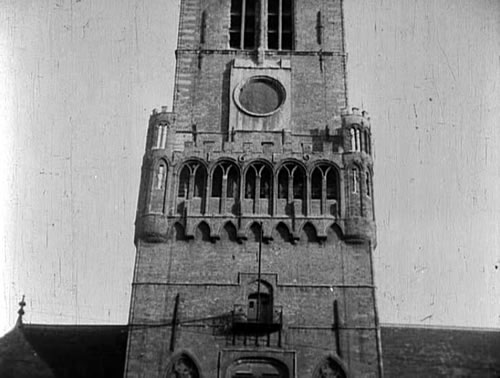
Fig. 6
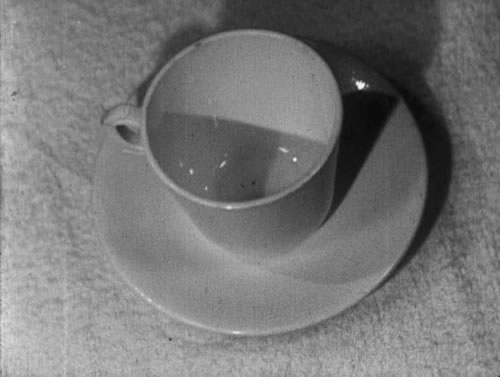
Fig. 7
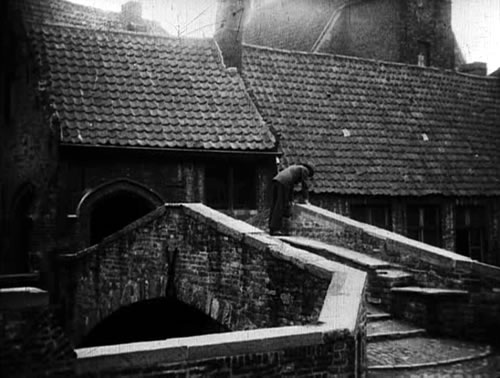
Fig. 8
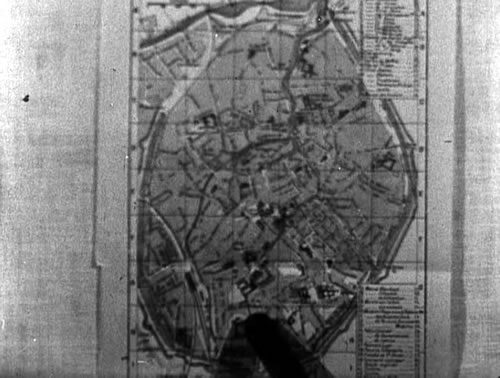
Fig. 9
The film then intercuts various shots of the bridge and coffee cup with shots
of Mme. Jonathan worrying in Brussels. In the shots just listed, Dekeukeleire
chips away at his narrative by showing the things his protagonist did not see.
(All this is doubly ironic since Bruges’s central district is very small;
Jonathan could hardly have been on an old bridge there without seeing some of
the sights listed.) Dekeukeleire also lengthens the titles beyond their narrative
functioning by adding guidebook phrases to each description.
The overall result of tactics like this is a film which seems almost to have
an invisible narrative. The titles make the story line clear enough, but in watching
the film the spectator cannot really see the narrative being worked out. The
images don’t contradict what the titles present, but only occasionally
do they show anything which adds to or really tallies with the verbal descriptions
(except in a passive way, as with Jonathan sitting on the bridge as the titles
describe him “not seeing” things). I don’t mean to suggest
that the film is uninteresting—its violent camera movements and rhythmic
montages tend to add some of the qualities of an abstract film. And, as one strains
to discover the narrative significance of these shots, their very opacity makes
them intriguing.
The irony of all this seems to have been lost on at least some spectators.
One reviewer, Marcel Rival, liked the film fairly well, especially its beautifully
photographed landscapes; but, said Rival:
It is this beauty, it is this calm, it is this limpid air, this joyous river
which De Keukeleire would like to see ruined, broken, infected, dried up for
the pleasure of creating there a dam and factory. De Keukeleire does not seem
to love virgin Nature much and he prefers a factory creating fumes, misery, pollution,
ugliness. He hates trees but cherishes concrete poles. 17 17
Faced with such incomprehension from his small public, Dekeukeleire shifted
his tactics once again for his next film. In Witte Vlam, as we have
seen, the political subject matter is more overt.
IV. Conclusions
Ultimately Dekeukeleire may seem so modern because, unlike most other filmmakers
of his day, he was working mainly against the traditions which then
existed. Other independent filmmakers were working to establish genres like pure
cinema, or surrealism, or documentary. The conception of film as an art form
was barely a decade old, and most people interested in cinema were still caught
up in the attempt to explore the medium’s possibilities. Yet Dekeukeleire
made one non-narrative film, Impatience, which was nevertheless not pure cinema
either. Nor did he present his films as the objects of pleasant aesthetic contemplation,
as with abstracts like Ruttmann’s Opus I, II, and so on, Fischinger’s Studies, or
Len Lye’s Tusalava.
Perhaps above all, Dekeuekeleire’s two masterpieces frustrated the spectator’s
urge toward narrative interpretation: Impatience’s suggestion
of a narrative situation which never emerges, and Histoire de détective’s
excessive dependence on written texts work upon narrative without either confirming
or denying it. This approach has become relatively comprehensible to modern audiences
through films like Michael Snow’s ↔ and Wavelength, which also touch
upon narrative potentials and then deny them to the spectator. At the time when
Dekeukeleire’s films were made, the filmmakers’ sympathizers manly
defended them by pushing them toward abstraction (a poem, a sonata). His detractors,
on the other hand, battened onto their incomprehensibility as narratives and
their pointless repetitions. The failure of the films to fit into recognizable
categories with which the spectators could cope probably contributed to his work’s
current obscure position. Brought out again today and exhibited to wider audiences,
Dekeukeleire’s experimental films could undoubtedly find sympathetic viewers.
Notes
This article would not have been possible without the extremely kind and friendly
cooperation of the staff of the Royal Film Archive of Belgium, and especially
Jacques Ledoux and Danielle Nicholas. My thanks to them for their help and advice.
The Royal Film Archive has several clipping files on Dekeukeleire, some of
the contents of which the filmmaker himself donated. He labeled his clippings
briefly, but often did not note dates and page numbers. Hence I am not always
able to give complete bibliographical information in every endnote, but I have
marked these items as available in the Dekeukeleire files.
All translations are my own.
1 : Hans Scheugl and Ernst
Schmidt, Jr., Eine Subgeschichte des Films: Lexicon des Avantgarde-, Experimental-,
und Undergroundfilms, Vol. I (Frankfurt am Main: Surkamps Verlag, 1974),
p. 179.
2 : All information
on ciné-clubs from Francis Bolen, Histoire authentique, anecdotique,
folklorique et critique de cinéma Belge depuis ses plus lointaires origines (Brussels:
Memo and Codec, 1978), pp. 83-86.
3 : R. S., “Un
cineaste belge: Charles Dekeukeleire,” Le Moustique (March 14,
1938—penciled date), n.p. Clipping file.
4 : A. F., “Charles Dekeukeleire nous parle de ses debuts,” no
source (June 4, 1940—pencilled date), n.p. Clipping file.
5 : Charles Dekeukeleire, “Explication
de la crise du cinéma,” Pt. II XXe siécle (Brussels,
June 30, 1933), n.p. Clipping file.
6 : Charles Dekeukeleire, “Biographie,” typescript
resumé, clipping file.
7 : Correspondence between Dekeukeleire and his lawyer, clipping file.
8 : Geo. Charles, “Combat
de boxe, le film de notre collaborateur devant le public parisien,” Dernièrs
Nouvelles (Brussels?, March 30, 1928), n.p. Clipping file.
9 : Ch. Delpierre, “Entretien
avec Dekeukeleire,” Les Beaux-Arts (January 9, 1031), n.p. Clipping
file.
10 : Ibid.
11 : Dekeukeleire, “Explication
de la crise du cinéma.”
12 : A. Kraszna-Krausz, “Exhibition
in Stuttgart, June, 1929, and Its Effects,” Close-up V, 6 (December
1929), p. 460.
13 : Club du cinéma, “Programme de la 36ième séance,” (March 13, 1929). Clipping file.
14 : Henri Storck, “Au Club du cinéma,” Le Carillon (Ostende ?, February 1929—pencilled date), n.p. Clipping file.
15 : Flouquet, “En
dessinant Charles Dekeukeleire,” Aurore (Paris, April 22, 1929),
n.p. Clipping file.
16 : Paul Werrie, “L’Oeuvre
de Ch. Dekeukeleire, or le lyrisme documentaire,” Reflets (Brussels,
April 1940): 7. Clipping file.
17 : Maurice Rival, “Histoire
de détective,” Film-Revue (n.d.), p. 10. Clipping
file.
|
|



